|
|
|
Sort Order |
|
|
|
Items / Page
|
|
|
|
|
|
|
| Srl | Item |
| 1 |
ID:
163550


|
|
|
|
|
| Summary/Abstract |
Municipal solid waste in China has increased rapidly in recent years with urbanization and economic development. The establishment of affordable, effective and truly sustainable waste management is a key point for the development of urban areas. However, as a renewable energy, the cost-benefit of supporting and the environmental performance for waste incineration power are seldom discussed. This paper discusses the current situation of waste incineration power industry in China and analyzes the required subsidies and emission reductions. The results show that waste incineration power needs relatively less financial support and perform well on emission reduction. Main obstacles to the development of waste incineration have also been investigated from the perspective of government, enterprises and local residents. Lastly, some suggestions are offered on how to tackle these issues. For instance: more regulation on waste classification; to integrate the informal workers into formal municipal waste management system; to communicate more effectively to the public to dispel general misunderstanding; application of the waste heat from cogeneration plants to local heat supply or central heat supply system.
|
|
|
|
|
|
|
|
|
|
|
|
|
|
|
|
| 2 |
ID:
166706
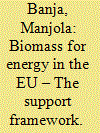

|
|
|
|
|
| Summary/Abstract |
This paper aims to produce a quantitative approach on the overall measures and on public support framework for biomass for energy, based on the EU countries reports under RED and existing literature. The way in which the support for biomass is implemented in the EU energy sector is not similar across EU countries. Feed-in tariffs and feed-in-premiums are still the dominant support schemes for the deployment of bioelectricity, whereas subsidies remain the main support for bioheat. Furthermore, a vast number of EU countries apply mandatory blending quotas for biofuels for transport. The paper shows that biomass for energy has a key role within the EU policy support for RES, in which targets are the main drivers, together with overarching biomass guidelines to anticipate any environmental constraints. Stable support showed the highest effectiveness in the past and remains the key factor for biomass deployment beyond 2020. The renewed targets need to be accompanied by long-term support measures and a commonly shared policy vision. A further harmonization of public bioenergy support towards a single EU cleaner energy market is recommended. This implies four policy actions for all EU countries: in-depth efficiency review, integration with RED-2, compatible sustainability guidelines and local impact assessments.
|
|
|
|
|
|
|
|
|
|
|
|
|
|
|
|
| 3 |
ID:
150443
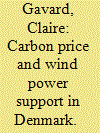

|
|
|
|
|
| Summary/Abstract |
This paper aims at characterizing the conditions of wind power deployment in order to infer a carbon price level that would provide wind power with comparable advantage over fossil fuel technologies as effective wind support policies. The analysis is conducted on Denmark after the electricity market liberalization. Probit and tobit techniques are employed to take account of a potential threshold effect. I find that the level and type of the support policy are the dominant drivers of deployment. A feed-in tariff significantly brings more wind power in than a premium policy. The additional capacity installed monthly increases by more than 1 MW for each additional €/MWh of support. This is compared to the effect of the electricity price, investment cost, interest rate and general economic activity. If the policy is a premium, I find that 23€/MWh of support in addition to electricity price is needed to observe the connection of new turbines to the grid with a 0.5 probability. I convert this support level into a carbon price of 27€/ton if wind power competes with coal, and 48€/t if it competes with gas.
|
|
|
|
|
|
|
|
|
|
|
|
|
|
|
|
| 4 |
ID:
131145
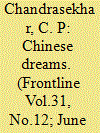

|
|
|
|
|
| Publication |
2014.
|
| Summary/Abstract |
Becoming another China is not easy as that will involve the reduction of expenditure on food subsidies and other welfare measures.
|
|
|
|
|
|
|
|
|
|
|
|
|
|
|
|
| 5 |
ID:
166300


|
|
|
|
|
| Summary/Abstract |
We investigate the economic impacts of policies for coordinating electricity production in the Gulf Cooperation Council (GCC) through electricity trade. The GCC countries have installed a network of high-voltage transmission lines that links Saudi Arabia, Bahrain, Kuwait, Oman, Qatar, and the United Arab Emirates. The Interconnector has successfully provided reliability services but has not yet realized its full potential as a platform to fully integrate the individual electricity systems.
|
|
|
|
|
|
|
|
|
|
|
|
|
|
|
|
| 6 |
ID:
166407


|
|
|
|
|
| Summary/Abstract |
This paper examines the biggest house energy efficiency retrofit support program in Greece which ran during 2011–2015 and approximately fifty thousand households participated. We take advantage of an exogenous policy change resulting in cost reduction for households that occurred while the program was running. This change substantially increased the subsidy rate for lower-income households. We find that this effective cost reduction increased the participation rate (extensive margin). We add to the literature on retrofits by further showing that this change increased substantially the investment amount (intensive margin) of these lower-income households. Detailed data on a sub-sample of households reveal that this increase was driven primarily by window replacement and thermal insulation investments.
|
|
|
|
|
|
|
|
|
|
|
|
|
|
|
|
| 7 |
ID:
166484
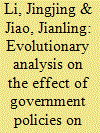

|
|
|
|
|
| Summary/Abstract |
In response to severe energy and environmental challenges, electric vehicles (EVs) have been thoroughly considered by governments. Although China has become the largest EV market, currently the limitations of EVs and decreasing subsidies have led to a challenging future. To promote EV diffusion, we use a complex network evolutionary game method to explore the dynamic impacts of government policies on EV diffusion in different scale networks. The results show that with the increase in manufacturers in the network, the degree of EV diffusion increases accordingly at the same government policy level. In the present network scale of manufacturers, on the supply side, the effects of tax and subsidy policies can respectively promote EV diffusion to 0.82 and 0.86. Fuel vehicle (FV) license plate restrictions and consumer purchase subsidies are effective policies on the demand side, which both can promote EV diffusion to 0.84. Compared with consumer purchase subsidies, production subsidies for manufacturers have better effects on EV diffusion. Neither the tax and subsidy policies nor the FV license plate restriction and EV purchase subsidy policies can realize full EV diffusion. Finally, combined with the current status of China's automobile industry, the corresponding policy recommendations for different periods are given.
|
|
|
|
|
|
|
|
|
|
|
|
|
|
|
|
| 8 |
ID:
150825
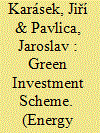

|
|
|
|
|
| Summary/Abstract |
The key goal of this study was to analyse application of the Green Investment Scheme in the Czech Republic through the Green Savings Programme finalising in 2015. The programme was evaluated in terms of aspects of both reduction effectiveness and economic aspects of the basic subsidy categories: (a) Insulation; (b) Low-Energy Houses; (c) Biomass Boilers; (d) Solar Thermal Systems and (e) Heat Pumps. The essential results of the programme were also covered, including the number of projects supported, the total volume of emission reduction and the volume of financial funding.
|
|
|
|
|
|
|
|
|
|
|
|
|
|
|
|
| 9 |
ID:
162340
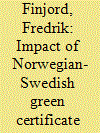

|
|
|
|
|
| Summary/Abstract |
In order to encourage investments in the most cost-effective renewable energy projects, Norway and Sweden have implemented a joint green certificate subsidy system, where the certificates are traded on a common market. The policies applied in the two countries, however, are not identical and differ most notably by the deadlines for receiving the subsidy. From the policy perspective, the important question is how these differences affect investment behavior in the renewable sector. This paper investigates the impact of the green certificate subsidy scheme on the value of renewable energy investments from the perspective of both Norwegian and Swedish investors based on a wind energy case study. We find that the impact of the policy is greatest when the distinctive Norwegian investment deadline is approaching, making investment optimal for the Norwegian investor for a larger range of prices. The Swedish investor, having no deadline to meet, will be more reluctant to investing. Furthermore, we find that the possibility of a collapse in the green certificate price reduces the values of the investment options. Being able to learn about the likelihood of such a price collapse leads to a small increase in the values of the options.
|
|
|
|
|
|
|
|
|
|
|
|
|
|
|
|
| 10 |
ID:
162335
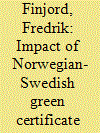

|
|
|
|
|
| Summary/Abstract |
In order to encourage investments in the most cost-effective renewable energy projects, Norway and Sweden have implemented a joint green certificate subsidy system, where the certificates are traded on a common market. The policies applied in the two countries, however, are not identical and differ most notably by the deadlines for receiving the subsidy. From the policy perspective, the important question is how these differences affect investment behavior in the renewable sector. This paper investigates the impact of the green certificate subsidy scheme on the value of renewable energy investments from the perspective of both Norwegian and Swedish investors based on a wind energy case study. We find that the impact of the policy is greatest when the distinctive Norwegian investment deadline is approaching, making investment optimal for the Norwegian investor for a larger range of prices. The Swedish investor, having no deadline to meet, will be more reluctant to investing. Furthermore, we find that the possibility of a collapse in the green certificate price reduces the values of the investment options. Being able to learn about the likelihood of such a price collapse leads to a small increase in the values of the options.
|
|
|
|
|
|
|
|
|
|
|
|
|
|
|
|
| 11 |
ID:
093526


|
|
|
|
|
| Publication |
2010.
|
| Summary/Abstract |
Given its importance as a practical phenomenon underlying the progress of learning technologies, attention should be paid to the role of subsidisation in learning theory, particularly in the case of nascent climate-related sociable learning technologies, in order to examine its benefits. Thus, this study focuses on subsidy procurement of energy technologies in several economies in the context of the component learning track in endogenous global clusters in order to suggest improvements to the adoption mechanism and examine the climate stabilization constraint. At the same time, the study attempts to determine the global progress ratio of the lithium-ion battery in order to analyse various endogenous learning scenarios for hybrid technologies. An integrated energy system model with highly disaggregated global regions (DNE21+) is used to execute this research in a medium time frame. Subsidisation of the learning track of battery technology encourages greater development of plug-in hybrid vehicles, promotes early diffusion of hybrid technologies, and relieves heavy dependency on crude oil and biofuels. The subsidies in the common learning domains in few economies benefit the nearby economies because of the technology spillover that occurs through numerous cross-feedback learning mechanisms. Endogenous learning with subsidies augments diffusion potentials, abates emissions, and shifts sectoral emissions.
|
|
|
|
|
|
|
|
|
|
|
|
|
|
|
|
| 12 |
ID:
115158


|
|
|
|
|
| Publication |
2012.
|
| Summary/Abstract |
Enhanced environmental quality, fuel security, and economic development, along with reduced prices of blended diesel, are often used as justifications for a U.S. federal excise tax exemption on biodiesel fuels. However, the possible effect of increased overall consumption of fuel in response to lower total prices, mitigating the environmental and fuel security benefits, are generally not considered. Taking this price response into account, the optimal U.S biodiesel subsidy is derived. Estimated values of the optimal subsidy are close to the recently expired subsidy, revealing the subsidy's environmental and security benefits. However, further positive environmental and security benefits from the biodiesel tax-exemption subsidy may be obtained if the subsidy is combined with a federal excise tax on petroleum diesel.
|
|
|
|
|
|
|
|
|
|
|
|
|
|
|
|
| 13 |
ID:
143394
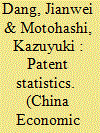

|
|
|
|
|
| Summary/Abstract |
Using a merged dataset of Chinese patent data and industrial survey data, we make a bibliometric analysis of patenting activities of Chinese large and medium-sized enterprises under local patent subsidy programs and test whether patent statistics are a good indicator of innovation in China. Our empirical results show that patent count is correlated with R&D input and financial output, which suggests that patent statistics are meaningful indicators. However, patent subsidy programs increase patent counts more than 30%. We emphasize the necessity of adjustments and provide a novel method of using the number of nouns in claims to quantify the claim scope, thereby overcoming the shortcomings of Chinese patent data that have no citations or lack well-documented patent claim information. We extend prior studies on patent subsidy programs by providing a detailed clarification of policy designs and their impacts and by evaluating policy impacts on both the quantity and quality of patent applications.
|
|
|
|
|
|
|
|
|
|
|
|
|
|
|
|
| 14 |
ID:
178815


|
|
|
|
|
| Summary/Abstract |
China is undergoing an energy-market reform while the residential sector remains the most prudent for its close relationship with livelihood. Based on the Chinese household energy consumption survey, a demand function is established to estimate the determinants of residential electricity consumption. With a micro-model, the changes in welfare and redistribution under different scenarios are estimated. From the results, the current subsidy is ineffective; each high-income family receives the cross-subsidy of 35.65 CNY per month, which is 3 times of the low-income family. Price increment leads to less subsidy and deadweight loss but a loss in welfare, and the adjustment in the price on the 1st block is more conducive to the subsidy decline. With a similar overall effect, the non-uniform increase is more effective in subsidy redistribution by widening the price gradients between IBP (increasing block price) blocks and is recommended. Considering the burden of subsidy, the government and the power grid companies are suggested to clarify the pricing scheme to help the public get informed, and thereby, win the support of the public in the energy reform.
|
|
|
|
|
|
|
|
|
|
|
|
|
|
|
|
| 15 |
ID:
122666
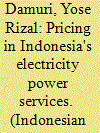

|
|
|
| 16 |
ID:
159773


|
|
|
|
|
| Summary/Abstract |
Despite successive attempts to effectively manage Nigeria’s downstream oil sector by strengthening the country’s institutional capacity, the Nigerian public institutions remain ineffective, inefficient, wasteful, incapacitated, inept, unprofessional and uninspired to drive the reform in the downstream oil sector. Public institutions have failed to successively oversee management of the downstream oil sector. This paper draws on the new public management theory and unstructured interviews to assess the role of public institutions in the distribution and marketing segments of the oil sector. It concludes that poor public sector performance is responsible for the crisis in the oil industry that led to subsidy cuts and efforts to deregulate the downstream oil sector.
|
|
|
|
|
|
|
|
|
|
|
|
|
|
|
|
| 17 |
ID:
169735
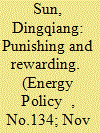

|
|
|
|
|
| Summary/Abstract |
Crop straw is the most important source of domestic energy in rural areas of many developing countries. However, as household income grows, rural residents begin to disuse crop straw, leading to a serious pollution and waste of biomass resources. This paper empirically examines the effect of public policy on crop straw use in the case of Jiangsu Province of China. Policy measures, such as burning ban and incentive programs for comprehensive use of crop straw, have important implication for rural energy supply and sustainable development of agriculture. Our results show that the burning ban has reduced crop straw burning in open field dramatically and driven farmers to retain straw into soil in sample areas. Straw retention subsidy, however, seems to play an insignificant role as the subsidy was low and not directly delivered to farmers. Moreover, crop straw markets in Jiangsu are inactive due partially to high cost of collecting and transporting crop straw, which may impose a big chanellge for straw-based energy plants that require larger scale and stable supply of crop straw. Our findings provide critical knowledge on designing and reforming current programs for crop straw management.
|
|
|
|
|
|
|
|
|
|
|
|
|
|
|
|
| 18 |
ID:
152074
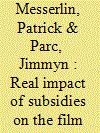

|
|
|
|
|
| Summary/Abstract |
Many countries are becoming interested in developing their film industries as a way of promoting their national culture and increasing their soft power. With the continued global dominance of Hollywood films, policy makers are increasingly considering government subsidies as an essential tool in promoting their national film industries. However, the actual effectiveness of subsidies in promoting a film industry remains debatable. In order to better address this issue, this paper evaluates and compares the experiences of France and Korea. Both countries have adopted exactly the same sequence of instruments—import quotas, screen quotas, and then subsidies—yet have applied almost the opposite subsidy policies. Since the 1950s, France has intensively used subsidies while Korea has not. After more than a half century, these different subsidy policies have led to very different outcomes. This paper shows that a film industry without significant government subsidies can prosper better in the long term than a heavily subsidized one. This is an important lesson for countries that want to develop their film industry and to promote their culture by designing effective film policies.
|
|
|
|
|
|
|
|
|
|
|
|
|
|
|
|
| 19 |
ID:
128374


|
|
|
|
|
| Publication |
2014.
|
| Summary/Abstract |
In this paper, we extend previous reference-dependence newsvendor research by incorporating both consumer trade-offs and government subsidies to evaluate the relevant influences on the optimal electric vehicle (EV) production decisions. We present the properties of the model, derive the closed-form solutions for the model given the relevant constraints, and use numerical experiments to illustrate the results. We find that subsidies, loss aversion, the performance of both EVs and internal combustion engine-powered vehicles (ICEVs), and the coefficient of variation of demand are significant factors influencing the optimal production quantity and the expected utilities of EV production. The high selling price and other high costs of ICEVs help offset the influence of loss aversion, whereas the high costs of EV enhance loss aversion. Our study enriches the literature on subsidies for EVs by establishing a behavioral model to incorporate the decision bias in terms of loss aversion at the firm level. These findings provide guiding principles for both policymakers and EV managers for making better strategies to promote EVs in the early immature market.
|
|
|
|
|
|
|
|
|
|
|
|
|
|
|
|
| 20 |
ID:
184106
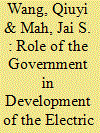

|
|
|
|
|
| Summary/Abstract |
As one of the technology-intensive industries, the electric vehicle (EV) industry has attracted the attention of the Chinese government. It has provided various incentives for the purchase of EVs, including tax incentives, policy loans at preferential interest rates and the establishment of charging facilities. EV production technology developed rapidly and sales of EVs increased significantly during the 2010s. The role of the government seems to have been of vital importance to the rapid development of the EV industry in China. To improve this further, it would be helpful for the government to efficiently coordinate various policy measures benefitting the EV industry and create a more suitable social environment for consumers to use EVs. The government should also carefully consider how to improve the applicability of EVs in different regional surroundings. In addition, efficient collaboration between the electronics industry and the automobile industry would be critical.
|
|
|
|
|
|
|
|
|
|
|
|
|
|
|
|
|
|
|
|
|